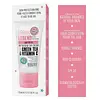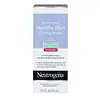What's inside
What's inside
 Key Ingredients
Key Ingredients

 Benefits
Benefits

 Concerns
Concerns

 Ingredients Side-by-side
Ingredients Side-by-side

Octocrylene 3%
UV AbsorberWater
Skin ConditioningC12-15 Alkyl Benzoate
AntimicrobialGlycerin
HumectantTribehenin
EmollientAlcohol Denat.
AntimicrobialAluminum Starch Octenylsuccinate
AbsorbentDimethicone
EmollientCetearyl Glucoside
EmulsifyingAmmonium Acryloyldimethyltaurate/Vp Copolymer
Phenoxyethanol
PreservativePotassium Cetyl Phosphate
EmulsifyingPanthenol
Skin ConditioningPolysorbate 20
EmulsifyingTocopheryl Acetate
AntioxidantDimethiconol
EmollientCaprylyl Glycol
EmollientAscorbyl Glucoside
AntioxidantBisabolol
MaskingSodium Benzoate
MaskingXanthan Gum
EmulsifyingEthylhexylglycerin
Skin ConditioningParfum
MaskingCitric Acid
BufferingSimethicone
EmollientSphinganine
Skin ConditioningTetrasodium EDTA
Dipropylene Glycol
HumectantPotassium Hydroxide
BufferingT-Butyl Alcohol
PerfumingDimethylmethoxy Chromanol
AntioxidantCamellia Sinensis Leaf Extract
AntimicrobialBHT
AntioxidantOctocrylene 3%, Water, C12-15 Alkyl Benzoate, Glycerin, Tribehenin, Alcohol Denat., Aluminum Starch Octenylsuccinate, Dimethicone, Cetearyl Glucoside, Ammonium Acryloyldimethyltaurate/Vp Copolymer, Phenoxyethanol, Potassium Cetyl Phosphate, Panthenol, Polysorbate 20, Tocopheryl Acetate, Dimethiconol, Caprylyl Glycol, Ascorbyl Glucoside, Bisabolol, Sodium Benzoate, Xanthan Gum, Ethylhexylglycerin, Parfum, Citric Acid, Simethicone, Sphinganine, Tetrasodium EDTA, Dipropylene Glycol, Potassium Hydroxide, T-Butyl Alcohol, Dimethylmethoxy Chromanol, Camellia Sinensis Leaf Extract, BHT
Butyl Methoxydibenzoylmethane 1.5%
UV AbsorberEthylhexyl Salicylate 5%
UV AbsorberOctocrylene 3%
UV AbsorberBenzophenone-3 4%
UV AbsorberWater
Skin ConditioningGlycolic Acid
BufferingC12-15 Alkyl Benzoate
AntimicrobialDicaprylyl Maleate
EmollientCetyl Alcohol
EmollientGlycerin
HumectantStearic Acid
CleansingGlyceryl Stearate
EmollientPEG-100 Stearate
Sodium Hydroxide
BufferingPhenoxyethanol
PreservativeSclerotium Gum
Emulsion StabilisingTocopheryl Acetate
AntioxidantCaprylyl Glycol
EmollientParfum
MaskingXanthan Gum
EmulsifyingMethylparaben
PreservativePanthenol
Skin ConditioningBisabolol
MaskingPropylparaben
PreservativeTetrasodium EDTA
Ascorbic Acid/Orange/Citrus Limon/Citrus Aurantifolia Polypeptides
Skin ConditioningButyl Methoxydibenzoylmethane 1.5%, Ethylhexyl Salicylate 5%, Octocrylene 3%, Benzophenone-3 4%, Water, Glycolic Acid, C12-15 Alkyl Benzoate, Dicaprylyl Maleate, Cetyl Alcohol, Glycerin, Stearic Acid, Glyceryl Stearate, PEG-100 Stearate, Sodium Hydroxide, Phenoxyethanol, Sclerotium Gum, Tocopheryl Acetate, Caprylyl Glycol, Parfum, Xanthan Gum, Methylparaben, Panthenol, Bisabolol, Propylparaben, Tetrasodium EDTA, Ascorbic Acid/Orange/Citrus Limon/Citrus Aurantifolia Polypeptides
Ingredients Explained
These ingredients are found in both products.
Ingredients higher up in an ingredient list are typically present in a larger amount.
Bisabolol is famous for its skin soothing properties. It does this by blocking inflammatory signals, helping to reduce your body's reaction to irritation.
This ingredient also interferes with the process of hyperpigmentation. This can help with reducing dark spots and uneven tone.
Bisabolol is an antioxidant. Antioxidants help fight free-radicals. Free-radicals are molecules that may damage your skin cells. By fighting these free-radicals, Bisabolol may slow down signs of aging.
Studies have shown Bisabolol to have antimicrobial properties and may be a fungicide. These properties help preserve a product's shelf life.
All these properties makes bisabolol a great skin barrier helper ingredient.
Bisabolol also helps the absorption of other ingredients.
Note: Synthetic Bisabolol has been shown to be less effective.
Learn more about BisabololC12-15 Alkyl Benzoate is made up of Benzoic Acid and long chain alcohols. It has a low molecular weight.
C12-15 Alkyl Benzoate is an emollient and texture enhancer. Due to its solubility, it is often used in sunscreens to help evenly distribute active ingredients.
As an emollient, C12-15 Alkyl Benzoate helps soften and hydrate your skin. Emollients create a film on your skin that traps moisture within.
This ingredient has been reported to cause eye irritation.
Learn more about C12-15 Alkyl BenzoateCaprylyl Glycol is a humectant and emollient, meaning it attracts and preserves moisture.
It is a common ingredient in many products, especially those designed to hydrate skin. The primary benefits are retaining moisture, skin softening, and promoting a healthy skin barrier.
Though Caprylyl Glycol is an alcohol derived from fatty acids, it is not the kind that can dry out skin.
This ingredient is also used as a preservative to extend the life of products. It has slight antimicrobial properties.
Learn more about Caprylyl GlycolGlycerin is already naturally found in your skin. It helps moisturize and protect your skin.
A study from 2016 found glycerin to be more effective as a humectant than AHAs and hyaluronic acid.
As a humectant, it helps the skin stay hydrated by pulling moisture to your skin. The low molecular weight of glycerin allows it to pull moisture into the deeper layers of your skin.
Hydrated skin improves your skin barrier; Your skin barrier helps protect against irritants and bacteria.
Glycerin has also been found to have antimicrobial and antiviral properties. Due to these properties, glycerin is often used in wound and burn treatments.
In cosmetics, glycerin is usually derived from plants such as soybean or palm. However, it can also be sourced from animals, such as tallow or animal fat.
This ingredient is organic, colorless, odorless, and non-toxic.
Glycerin is the name for this ingredient in American English. British English uses Glycerol/Glycerine.
Learn more about GlycerinOctocrylene protects skin from sun damage. It absorbs UV-B with peak absorption of 304 nm. It is a common sunscreen ingredient and often paired with avobenzone, a UVA filter. This is because octocrylene stabilizes other sunscreen ingredients by protecting them from degradation when exposed to sunlight. Octocrylene is a photostable ingredient and loses about 10% of SPF in 95 minutes.
Octocrylene also acts as an emollient, meaning it helps skin retain moisture and softens skin. It is oil-soluble and hydrophobic, enhancing water-resistant properties in a product.
Those who are using ketoprofen, a topical anti-inflammatory drug, may experience an allergic reaction when using octocrylene. It is best to speak with a healthcare professional about using sunscreens with octocrylene.
The EU allows a maximum of these concentrations:
Learn more about OctocrylenePanthenol is a common ingredient that helps hydrate and soothe the skin. It is found naturally in our skin and hair.
There are two forms of panthenol: D and L.
D-panthenol is also known as dexpanthenol. Most cosmetics use dexpanthenol or a mixture of D and L-panthenol.
Panthenol is famous due to its ability to go deeper into the skin's layers. Using this ingredient has numerous pros (and no cons):
Like hyaluronic acid, panthenol is a humectant. Humectants are able to bind and hold large amounts of water to keep skin hydrated.
This ingredient works well for wound healing. It works by increasing tissue in the wound and helps close open wounds.
Once oxidized, panthenol converts to pantothenic acid. Panthothenic acid is found in all living cells.
This ingredient is also referred to as pro-vitamin B5.
Learn more about PanthenolParfum is a catch-all term for an ingredient or more that is used to give a scent to products.
Also called "fragrance", this ingredient can be a blend of hundreds of chemicals or plant oils. This means every product with "fragrance" or "parfum" in the ingredients list is a different mixture.
For instance, Habanolide is a proprietary trade name for a specific aroma chemical. When used as a fragrance ingredient in cosmetics, most aroma chemicals fall under the broad labeling category of “FRAGRANCE” or “PARFUM” according to EU and US regulations.
The term 'parfum' or 'fragrance' is not regulated in many countries. In many cases, it is up to the brand to define this term.
For instance, many brands choose to label themselves as "fragrance-free" because they are not using synthetic fragrances. However, their products may still contain ingredients such as essential oils that are considered a fragrance by INCI standards.
One example is Calendula flower extract. Calendula is an essential oil that still imparts a scent or 'fragrance'.
Depending on the blend, the ingredients in the mixture can cause allergies and sensitivities on the skin. Some ingredients that are known EU allergens include linalool and citronellol.
Parfum can also be used to mask or cover an unpleasant scent.
The bottom line is: not all fragrances/parfum/ingredients are created equally. If you are worried about fragrances, we recommend taking a closer look at an ingredient. And of course, we always recommend speaking with a professional.
Learn more about ParfumPhenoxyethanol is a preservative that has germicide, antimicrobial, and aromatic properties. Studies show that phenoxyethanol can prevent microbial growth. By itself, it has a scent that is similar to that of a rose.
It's often used in formulations along with Caprylyl Glycol to preserve the shelf life of products.
Tetrasodium EDTA is the salt formed from neutralizing ethylenediamine tetraacetic acid with sodium hydroxide. It is a chelating agent and used to prevent metal ions from binding to other ingredients. This helps keep the product and ingredients stable.
Tetrasodium EDTA comes as a white solid and is soluble in water.
Tocopheryl Acetate is AKA Vitamin E. It is an antioxidant and protects your skin from free radicals. Free radicals damage the skin by breaking down collagen.
One study found using Tocopheryl Acetate with Vitamin C decreased the number of sunburned cells.
Tocopheryl Acetate is commonly found in both skincare and dietary supplements.
Learn more about Tocopheryl AcetateWater. It's the most common cosmetic ingredient of all. You'll usually see it at the top of ingredient lists, meaning that it makes up the largest part of the product.
So why is it so popular? Water most often acts as a solvent - this means that it helps dissolve other ingredients into the formulation.
You'll also recognize water as that liquid we all need to stay alive. If you see this, drink a glass of water. Stay hydrated!
Learn more about WaterXanthan gum is used as a stabilizer and thickener within cosmetic products. It helps give products a sticky, thick feeling - preventing them from being too runny.
On the technical side of things, xanthan gum is a polysaccharide - a combination consisting of multiple sugar molecules bonded together.
Xanthan gum is a pretty common and great ingredient. It is a natural, non-toxic, non-irritating ingredient that is also commonly used in food products.
Learn more about Xanthan Gum